History
Prisoners were transferred to Camp Albuquerque because it was closer to their work sites. These main and branch camps were part of a POW camp system spread across much of the United States. At its World War II peak, almost 426,000 prisoners - 371,683 German, 50,273 Italian, and 3,915 Japanese - were held in the United States. Beginning with 1,881 POWs in the United States at the end of 1942, was up to 172,879 by the end of 1943, and peaked at 425,871 on V-E Day.
From October 1943 Italian POWs were housed in Rio Grande Park in former Civilian Conservation Corps (CCC) barracks that had been built in the 1930s. The site was located north of the present day Rio Grande Zoo, founded in 1927. The Italian POWs all left six months later.
From 25 July 1944 until March 1946 German POWs, most of them captured in the North Africa campaigns, were housed in these same barracks buildings. The barracks had been moved to South 2nd Street and onto 8 acres (32,000 m2) at the north end of the Schwartzman property, and made ready for their arrival.
Shifting prisoner populations and transfers were routine. This was done to remove pro-Nazi troublemakers, and to help break up escape attempts and their all tunnel digging teams. Still, three Germans did escape from Camp Albuquerque, but two were soon recaptured.
At peak occupancy, sometime in 1945, there were 171 German POWs in branch Camp Albuquerque. They worked on the various farms from Los Lunas to Corrales, helping in particular with the harvest in the fall.
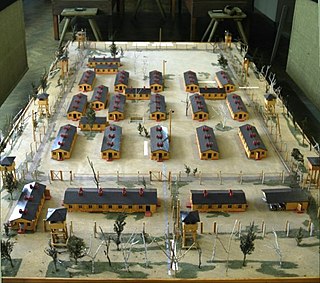
Stalag Luft III was a Luftwaffe-run prisoner-of-war (POW) camp during the Second World War, which held captured Western Allied air force personnel.

Stalag II-B was a German World War II prisoner-of-war camp situated 2.4 kilometres (1.5 mi) west of the town of Hammerstein, Pomerania on the north side of the railway line. It housed Polish, French, Belgian, Serbian, Dutch, Soviet, Italian and American prisoners of war.
Stalag III-C was a German Army World War II prisoner-of-war camp for Allied soldiers. It was located on a plain near the village of Alt Drewitz bei Küstrin then located in the Neumark of the province of Brandenburg, about 50 mi (80 km) east of Berlin.

In Germany, stalag was a term used for prisoner-of-war camps. Stalag is a contraction of "Stammlager", itself short for Kriegsgefangenen-Mannschaftsstammlager, a literal translation of which is "War-prisoner" "enlisted" "main camp". Therefore, technically "stalag" simply means "main camp".

Stalag XI-B and Stalag XI-D / 357 were two German World War II prisoner-of-war camps (Stammlager) located just to the east of the town of Fallingbostel in Lower Saxony, in north-western Germany. The camps housed Polish, French, Belgian, Soviet, Italian, British, Yugoslav, American, Canadian, New Zealander and other Allied POWs.

Stalag VIII-A was a German World War II prisoner-of-war camp, located just to the south of the town of Görlitz in Lower Silesia, east of the River Neisse. The location of the camp lies in today's Polish town of Zgorzelec, which lies over the river from Görlitz.
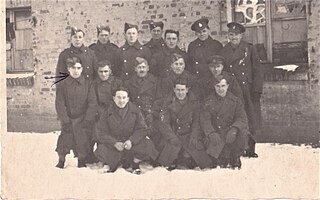
Stalag VIII-B was a German Army prisoner-of-war camp during World War II, later renumbered Stalag-344, located near the village of Lamsdorf in Silesia. The camp initially occupied barracks built to house British and French prisoners in World War I. At this same location there had been a prisoner camp during the Franco-Prussian War of 1870-71.

Stalag VIII-C was a German World War II prisoner-of-war camp, near Sagan, Lower Silesia. It was adjacent to the famous Stalag Luft III, and was built at the beginning of World War II, occupying 48 ha. It housed Allied POWs of various nationalities, incl. Polish, French, Belgian, British, Canadian, Greek, Yugoslav, Soviet, Australian, New Zealand, South African, Italian, Senegalese, Algerian, Moroccan and Slovak.
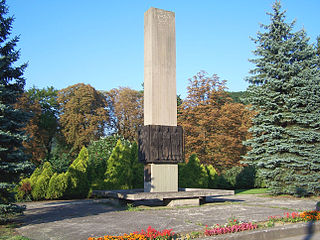
Stalag VIII-D was a German World War II prisoner-of-war camp (Stammlager) located at the outskirts of Teschen,. It was built in March 1941 on the grounds of a former Czech barracks. It was later known as Stalag VIII-B.

Stalag VII-A was the largest prisoner-of-war camp in Nazi Germany during World War II, located just north of the town of Moosburg in southern Bavaria. The camp covered an area of 35 hectares. It served also as a transit camp through which prisoners, including officers, were processed on their way to other camps. At some time during the war, prisoners from every nation fighting against Germany passed through it. At the time of its liberation on 29 April 1945, there were 76,248 prisoners in the main camp and 40,000 or more in Arbeitskommando working in factories, repairing railroads or on farms.
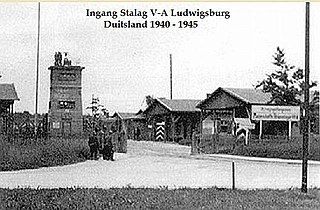
Stalag V-A was a German World War II prisoner-of-war camp (Stammlager) located on the southern outskirts of Ludwigsburg, Germany. It housed Allied POWs of various nationalities, including Poles, Belgians, Dutchmen, Frenchmen, Britons, Soviets, Italians and Americans.
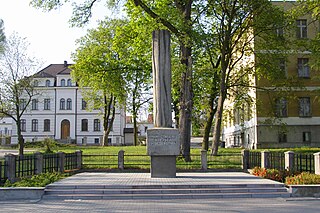
Oflag XXI-B and Stalag XXI-B were World War II German prisoner-of-war camps for officers and enlisted men, located at Szubin a few miles southwest of Bydgoszcz, Poland, which at that time was occupied by Nazi Germany.

During World War II, Nazi Germany engaged in a policy of deliberate maltreatment of Soviet prisoners of war (POWs), in contrast to their general treatment of British and American POWs. This policy, which amounted to deliberately starving and working to death Soviet POWs, the bulk of whom were Slavs, was grounded in Nazi racial theory, which depicted Slavs as sub-humans (Untermenschen). The policy resulted in some 3.3 to 3.5 million deaths.

Macikai POW and GULAG Camps refers to the complex of prisoner-of-war camp and forced labor camps located near Macikai (Matzicken) in German-occupied Lithuania and later, the Lithuanian SSR. The camp was opened and operated by Nazi Germany (1939–1944), and later became a Soviet prisoner-of-war camp No. 184 (1945–1948), finally transforming into a Soviet GULAG forced-labour camp (1945–1955). It was located in the village of Macikai, 2 kilometres away from Šilutė in occupied Lithuania.
Camp Beaver Dam was an American World War II prisoner of war camp in Beaver Dam, Wisconsin during the summer of 1944. The camp held 300 German prisoners of war in a tent city encampment where the Wayland Academy field house now stands.

Members of the German military were interned as prisoners of war in the United States during World War I and World War II. In all, 425,000 German prisoners lived in 700 camps throughout the United States during World War II.

Szebnie was a forced-labor camp established during World War II by Nazi Germany in the General Government in the south-eastern part of occupied Poland. It was located near the town of Szebnie approximately 10 kilometres (6 mi) east of Jasło and 42 km (26 mi) south-west of Rzeszów. The facility was constructed in 1940 originally as horse stables for the Wehrmacht, adjacent to a manorial estate where the German officers stationed (photo). Over the course of the camp's operation thousands of people perished there, including Soviet prisoners of war, Polish Jews, Poles, Ukrainians, and Romani people. The charred remains of the camp were entered by the Soviets on 8 September 1944.
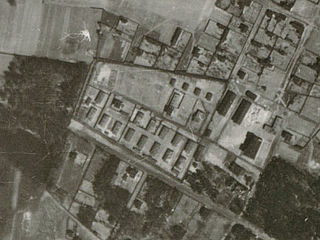
Stalag Luft II was a Luftwaffe-run prisoner-of-war (POW) camp during World War II, in Łódź, in the occupied territory of Poland.














